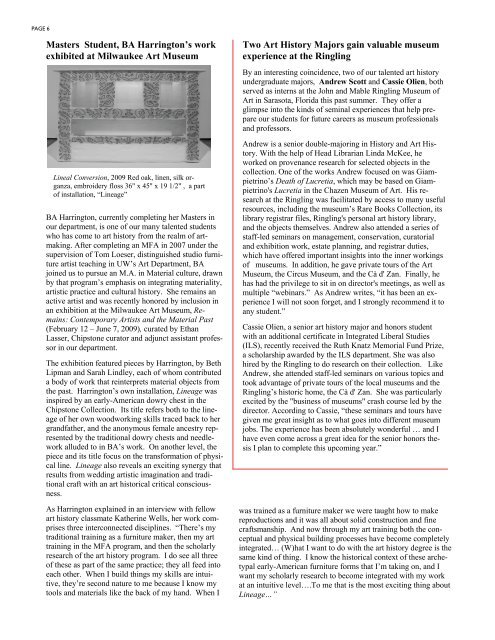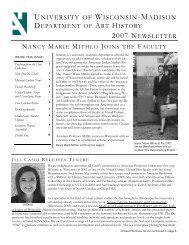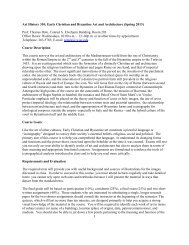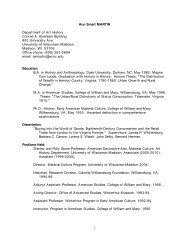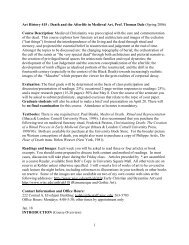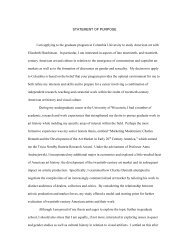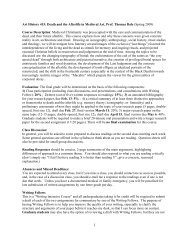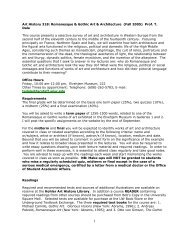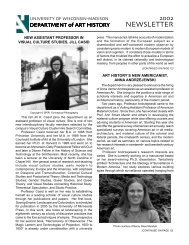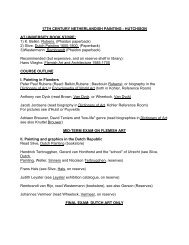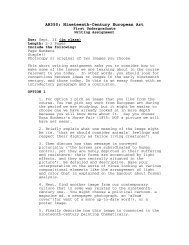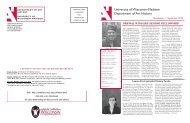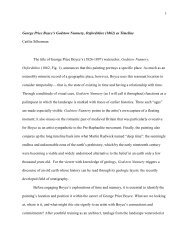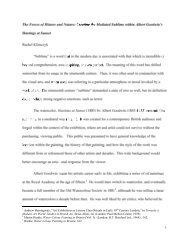newsletter 2009.pub - Art History - University of Wisconsin-Madison
newsletter 2009.pub - Art History - University of Wisconsin-Madison
newsletter 2009.pub - Art History - University of Wisconsin-Madison
You also want an ePaper? Increase the reach of your titles
YUMPU automatically turns print PDFs into web optimized ePapers that Google loves.
PAGE 6<br />
Masters Student, BA Harrington’s work<br />
exhibited at Milwaukee <strong>Art</strong> Museum<br />
Lineal Conversion, 2009 Red oak, linen, silk organza,<br />
embroidery floss 36" x 45" x 19 1/2" , a part<br />
<strong>of</strong> installation, “Lineage”<br />
BA Harrington, currently completing her Masters in<br />
our department, is one <strong>of</strong> our many talented students<br />
who has come to art history from the realm <strong>of</strong> artmaking.<br />
After completing an MFA in 2007 under the<br />
supervision <strong>of</strong> Tom Loeser, distinguished studio furniture<br />
artist teaching in UW’s <strong>Art</strong> Department, BA<br />
joined us to pursue an M.A. in Material culture, drawn<br />
by that program’s emphasis on integrating materiality,<br />
artistic practice and cultural history. She remains an<br />
active artist and was recently honored by inclusion in<br />
an exhibition at the Milwaukee <strong>Art</strong> Museum, Remains:<br />
Contemporary <strong>Art</strong>ists and the Material Past<br />
(February 12 – June 7, 2009), curated by Ethan<br />
Lasser, Chipstone curator and adjunct assistant pr<strong>of</strong>essor<br />
in our department.<br />
The exhibition featured pieces by Harrington, by Beth<br />
Lipman and Sarah Lindley, each <strong>of</strong> whom contributed<br />
a body <strong>of</strong> work that reinterprets material objects from<br />
the past. Harrington’s own installation, Lineage was<br />
inspired by an early-American dowry chest in the<br />
Chipstone Collection. Its title refers both to the lineage<br />
<strong>of</strong> her own woodworking skills traced back to her<br />
grandfather, and the anonymous female ancestry represented<br />
by the traditional dowry chests and needlework<br />
alluded to in BA’s work. On another level, the<br />
piece and its title focus on the transformation <strong>of</strong> physical<br />
line. Lineage also reveals an exciting synergy that<br />
results from wedding artistic imagination and traditional<br />
craft with an art historical critical consciousness.<br />
As Harrington explained in an interview with fellow<br />
art history classmate Katherine Wells, her work comprises<br />
three interconnected disciplines. “There’s my<br />
traditional training as a furniture maker, then my art<br />
training in the MFA program, and then the scholarly<br />
research <strong>of</strong> the art history program. I do see all three<br />
<strong>of</strong> these as part <strong>of</strong> the same practice; they all feed into<br />
each other. When I build things my skills are intuitive,<br />
they’re second nature to me because I know my<br />
tools and materials like the back <strong>of</strong> my hand. When I<br />
Two <strong>Art</strong> <strong>History</strong> Majors gain valuable museum<br />
experience at the Ringling<br />
By an interesting coincidence, two <strong>of</strong> our talented art history<br />
undergraduate majors, Andrew Scott and Cassie Olien, both<br />
served as interns at the John and Mable Ringling Museum <strong>of</strong><br />
<strong>Art</strong> in Sarasota, Florida this past summer. They <strong>of</strong>fer a<br />
glimpse into the kinds <strong>of</strong> seminal experiences that help prepare<br />
our students for future careers as museum pr<strong>of</strong>essionals<br />
and pr<strong>of</strong>essors.<br />
Andrew is a senior double-majoring in <strong>History</strong> and <strong>Art</strong> <strong>History</strong>.<br />
With the help <strong>of</strong> Head Librarian Linda McKee, he<br />
worked on provenance research for selected objects in the<br />
collection. One <strong>of</strong> the works Andrew focused on was Giampietrino’s<br />
Death <strong>of</strong> Lucretia, which may be based on Giampietrino's<br />
Lucretia in the Chazen Museum <strong>of</strong> <strong>Art</strong>. His research<br />
at the Ringling was facilitated by access to many useful<br />
resources, including the museum’s Rare Books Collection, its<br />
library registrar files, Ringling's personal art history library,<br />
and the objects themselves. Andrew also attended a series <strong>of</strong><br />
staff-led seminars on management, conservation, curatorial<br />
and exhibition work, estate planning, and registrar duties,<br />
which have <strong>of</strong>fered important insights into the inner workings<br />
<strong>of</strong> museums. In addition, he gave private tours <strong>of</strong> the <strong>Art</strong><br />
Museum, the Circus Museum, and the Cà d' Zan. Finally, he<br />
has had the privilege to sit in on director's meetings, as well as<br />
multiple “webinars.” As Andrew writes, “it has been an experience<br />
I will not soon forget, and I strongly recommend it to<br />
any student.”<br />
Cassie Olien, a senior art history major and honors student<br />
with an additional certificate in Integrated Liberal Studies<br />
(ILS), recently received the Ruth Knatz Memorial Fund Prize,<br />
a scholarship awarded by the ILS department. She was also<br />
hired by the Ringling to do research on their collection. Like<br />
Andrew, she attended staff-led seminars on various topics and<br />
took advantage <strong>of</strong> private tours <strong>of</strong> the local museums and the<br />
Ringling’s historic home, the Cà d' Zan. She was particularly<br />
excited by the "business <strong>of</strong> museums" crash course led by the<br />
director. According to Cassie, “these seminars and tours have<br />
given me great insight as to what goes into different museum<br />
jobs. The experience has been absolutely wonderful … and I<br />
have even come across a great idea for the senior honors thesis<br />
I plan to complete this upcoming year.”<br />
was trained as a furniture maker we were taught how to make<br />
reproductions and it was all about solid construction and fine<br />
craftsmanship. And now through my art training both the conceptual<br />
and physical building processes have become completely<br />
integrated… (W)hat I want to do with the art history degree is the<br />
same kind <strong>of</strong> thing. I know the historical context <strong>of</strong> these archetypal<br />
early-American furniture forms that I’m taking on, and I<br />
want my scholarly research to become integrated with my work<br />
at an intuitive level….To me that is the most exciting thing about<br />
Lineage…”


